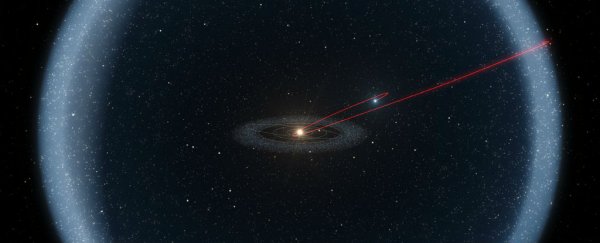A strange, rocky comet with no tail has been spotted zipping into our inner Solar System, and it's so unique, it's got scientists ready to rewrite the definition of what these ubiquitous cosmic bodies should look like.
According to a new report, the comet is carrying up to 1 million times less water than any other comet ever recorded, and it's made up of solid rock, like an asteroid, rather than ice, like a typical comet. So basically what we have here is a cross between an asteroid and a comet, and astronomers are flipping out.
"This is super exciting, because it could be a piece of what formed Earth," one of the team, Olivier Hainaut from the European Southern Observatory, told Maddie Stone from Gizmodo.
The tailless comet appears to have emerged from the Oort cloud - a vast, hypothetical bubble that encases the entire Solar System, and plays host to countless icy comets on its farthest edges.
The orbits of these Oort cloud comets brings them into the inner Solar System once every 200 to several thousands of years, and as they draw nearer to the Sun, their icy coating is stripped away, vapourising behind them like a tail.
But the thing about this new comet, called C/2014 S3, is that there's not enough ice on it to create a tail.
And even stranger, its spectrum - the pattern of light reflected off its surface - reveals that its rocky exterior hasn't been baked by the Sun like all known asteroids with orbits that take them between Mars and Jupiter.
So this thing appears to be a hybrid of an icy comet and a rocky asteroid, but it's unlike any comet or asteroid ever seen.
"If you'd shown me the spectrum, I would have just said this is another stupid asteroid," Hainaut told Stone. "If you showed me the orbit, I'd say yeah, it's a standard long-period comet. But you don't at all expect to find a rocky asteroid on an Oort cloud orbit. That's wrong."
The comet was first spotted in 2014, by astronomers using the PANSTARSS-S1 telescope in Hawaii.
After two years of observations and analysis, Hainaut and his team suspect that it was formed somewhere near Earth about 4 billion years ago, got bumped into the outer edges of the Solar System by a random collision, and spent most of its lifetime in the 'deep-freeze' of the Oort cloud. And now it's made its way back home for the first time.
All that time spent in the frigid conditions of the Oort cloud seems to have done something for the tailless comet, which the team is calling a Manx comet, after the tailless manx cat. The deep-freeze appears to have protected it against the crazy heat of the Sun.
"We already knew of many asteroids, but they have all been baked by billions of years near the Sun," said one of the team, Karen Meech, in a press statement. "This one is the first uncooked asteroid we could observe: it has been preserved in the best freezer there is."
(Note that even the researchers themselves don't know whether to call this an asteroid or a comet.)
Christina Beck reports for Christian Science Monitor that the trajectory of comet C/2014 S3 is similar to other comets in the Oort cloud - referred to as long-period comets, because they have such lengthy orbits. Its orbit is estimated to be about 860 years long, which means we're not going to be seeing it again for some time.
It's now up to astronomers to try and identify more 'hybrid' comets like this to test their models, and figure out if they could actually be remnants of the materials that first formed Earth, and if they are, that could tell us a whole lot about our planet's early years.
"We've found the first rocky comet, and we are looking for others," says Hainaut. "Depending how many we find, we will know whether the giant planets danced across the Solar System when they were young, or if they grew up quietly without moving much."
The report has been published in Science Advances.
